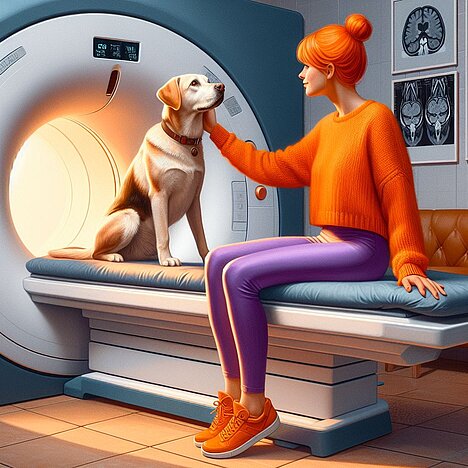Magnetic resonance imaging

You've probably wondered how magnetic resonance imaging (MRI) works in dogs. This article will tell you everything you need to know about it. We'll explain what MRI is, how it's used, what the benefits are and what you should bear in mind if your dog needs an MRI scan.
What is MRI?
MRI is an imaging procedure that uses magnetic fields and radio waves to produce detailed images of the inside of the body. MRI can differentiate between different types of tissue and thus make tumors, inflammations or injuries visible, for example. MRI is not harmful to the body as it does not use X-rays.
How is MRI used in dogs?
MRI in dogs is mostly used to diagnose diseases of the brain or spine. For example, MRI can help to detect a stroke, a herniated disc or a brain tumor. However, MRI can also show other organs such as the heart, lungs or liver.
To carry out an MRI scan, the dog must be placed in a tube that generates the magnetic field. As the dog has to lie still and the examination takes around 30 to 60 minutes, it is usually put under anesthesia beforehand. During the examination, the dog is monitored and protected from the loud noise of the MRI with headphones.
What are the advantages of MRI in dogs?
MRI in dogs has many advantages over other imaging techniques such as X-rays or ultrasound. MRI can provide very accurate and high-resolution images that can show even the smallest changes in tissue. MRI can also show areas that are difficult to access with other methods, such as the brain or spinal cord. MRI is also non-invasive and not painful for the dog.
What should you consider if your dog needs an MRI scan?
If your dog needs an MRI scan, you should be well prepared for it. You should not give your dog any food the day before the examination so that his stomach is empty. You should also remove all metal objects from your dog, such as collars, harnesses or chips. These can interfere with the magnetic field or heat up.
You should also be aware that your dog may be a little dizzy after the anesthetic. He will then need rest and lots of attention. You should also only offer him small amounts of water and food to avoid nausea.
The MRI examination is not dangerous for your dog, but it can still involve risks. For example, there may be allergic reactions to the anesthetic or complications during anesthesia. You should therefore always discuss with your vet whether the MRI scan is really necessary and what alternatives are available.
The authors assume that a veterinarian should be consulted if an animal is ill and that medication should only be taken after consultation with a doctor or pharmacist. Only an individual examination can lead to a diagnosis and treatment decision.
We help you find the nearest vet → This way